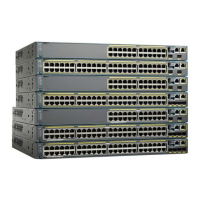Access List Numbers
The number you use to denote your ACL shows the type of access list that you are creating.
This lists the access-list number and corresponding access list type and shows whether or not they are supported
in the switch. The switch supports IPv4 standard and extended access lists, numbers 1 to 199 and 1300 to
2699.
Table 17: Access List Numbers
SupportedTypeAccess List Number
YesIP standard access list
1–99
YesIP extended access list
100–199
NoProtocol type-code access list
200–299
NoDECnet access list
300–399
NoXNS standard access list
400–499
NoXNS extended access list
500–599
NoAppleTalk access list
600–699
No48-bit MAC address access list
700–799
NoIPX standard access list
800–899
NoIPX extended access list
900–999
NoIPX SAP access list
1000–1099
NoExtended 48-bit MAC address access list
1100–1199
NoIPX summary address access list
1200–1299
YesIP standard access list (expanded range)
1300–1999
YesIP extended access list (expanded range)
2000–2699
In addition to numbered standard and extended ACLs, you can also create standard and extended named IP
ACLs by using the supported numbers. That is, the name of a standard IP ACL can be 1 to 99; the name of
an extended IP ACL can be 100 to 199. The advantage of using named ACLs instead of numbered lists is that
you can delete individual entries from a named list.
Catalyst 2960-X Switch Security Configuration Guide, Cisco IOS Release 15.0(2)EX
148 OL-29048-01
Configuring IPv4 ACLs
Standard and Extended IPv4 ACLs
